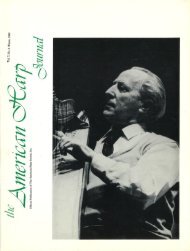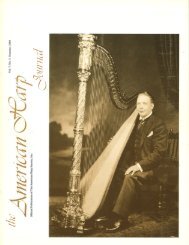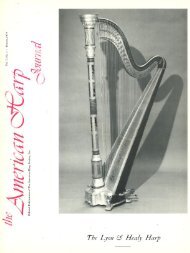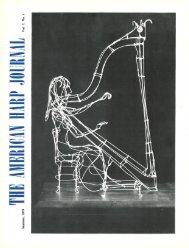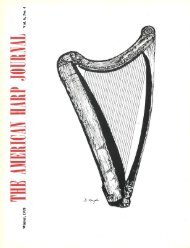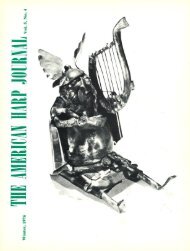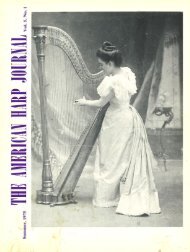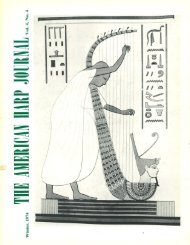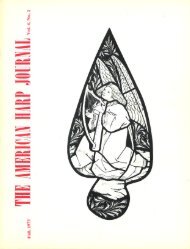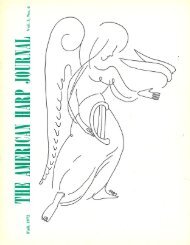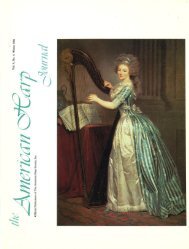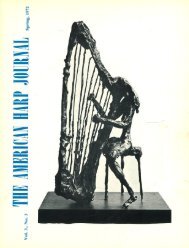You also want an ePaper? Increase the reach of your titles
YUMPU automatically turns print PDFs into web optimized ePapers that Google loves.
&nmp~ouu 8'ortrtg llullrttu<br />
It stirred up quite a tempest in a teapot,<br />
for the adherents of the older<br />
harp with pedals attacked the new<br />
invention immediately. It is a strange<br />
coincidence that the two works by<br />
Pierne and Debussy which figure in<br />
the Symphony Society's programmes,<br />
are dedicated to the two champions<br />
of the old and the new systems<br />
respectively.<br />
The pedal harp is, by reason of<br />
its construction, essentially diatonic.<br />
It never has more than seven tones<br />
available within the octave at any<br />
one time. It has only seven strings<br />
to the octave, each of which, however,<br />
throughout the whole compass of the<br />
instrument, can be raised at will<br />
through two successive half-tones by<br />
means of a double action pedal.<br />
There are thus seven pedals. All the<br />
strings lie in one vertical plane.<br />
The chromatic harp does away<br />
with the pedals and adds five strings<br />
for each octave, thus filling out the<br />
twelve chromatic steps of the octave.<br />
To adjust the new strings between<br />
the old ones in the same plane<br />
~oi!ld bring them all too close<br />
together for, the insertion of the<br />
player's finger. To equalize the<br />
spaces by increasing the span of the<br />
octave would remove the farther end<br />
of the scale beyon~ the player's reach.<br />
The difficulty is overcome by disposing<br />
the strings, without increasing the<br />
octave span, in two oblique planes<br />
which intersect like a thin le~ter "~.:".<br />
All the diatonic strings, corresponding<br />
to the white keys on the piano, lie in<br />
one plane. All the chromatic strings,<br />
;...,:responding to the black keys, lie<br />
in the other. By running his finger<br />
along the line of intersection the<br />
player can execute a perfect chromatic<br />
glissando.<br />
From 1894 to 1897, the inventor<br />
labored to perfect his instrument: In<br />
1897 it was exhibited at Brussels at<br />
the Exposition of Arts and Industries,<br />
where, at first, it attracted attention<br />
as a curiosity beside another Pleyel<br />
exhibit, a double piano wi.th two keyboards<br />
so disposed that the players<br />
faced each other. However, performances<br />
upon .. the new instrument at<br />
the Exposition by Jean Risler brother<br />
of the pianist, Edouard Risier soon<br />
revealed its possibilities. The' harp<br />
players of the old school began to<br />
grow uneasy. The Nestor of French<br />
harpists, Alphonse Hasselmans, . for<br />
many years professor of the harp at<br />
tha Paris Conservatoire ( from which<br />
position he retired in 1912 at the age<br />
of sixty-seven), took up the cudgels in<br />
defense of the pedal harp, and a lively<br />
polemic ensued between him and theinventor.<br />
Hasselmans insisted that<br />
the innovation "completely denatured<br />
the character of the instrument and<br />
made it scarcely a reduction of the<br />
piano".<br />
Criticism of the new harp was directed<br />
chiefly against the impossibility<br />
of securing the extremely varied<br />
and striking arpeggio and glissando<br />
effects which the use of the pedals<br />
made possible, and against its alleged<br />
lack of sonority as compared with the<br />
old instrument. Lyon denied these<br />
weaknesses and cites a performance<br />
"in the Cathedral of Orleans on the<br />
feast of Joan of Arc, -when four chromatic<br />
harps were placed side by ,side<br />
with four pedal harps and in the<br />
performance of Gounod's 'Redemption'<br />
and Cesar Franck' 'Procession'<br />
the results were absolutely conclusive".<br />
In spite of the opposition the new<br />
harp found favor. Richter and Mottl<br />
tried it out as an orchestra instrument.<br />
It has not, however, up to the present,<br />
succeeded in crowding the pedal harp<br />
1<br />
out of the orchestra. In 1901, Fran<br />




